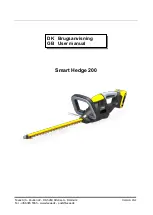
24
●
Do not operate hedge trimmer barefooted.
Hot Humid Weather
Heavy protective clothing can increase operator fatigue which
may lead to heat stroke.
Schedule heavy work for early morning or late afternoon hours
when temperatures are
cooler.
Extended operation and extreme conditions
Fig. 2
It is believed that a condition called Raynaud's Phenomenon,
which affects the fingers of certain individuals, may be brought
about by exposure to vibration and cold. Exposure to vibration
and cold may cause tingling and burning sensations, followed by
loss of color and numbness in the fingers. The following
precautions are strongly recommended, because the minimum
exposure, which might trigger the ailment, is unknown.
●
Keep your body warm, especially the head, neck, feet, ankles,
hands, and wrists.
●
Maintain good blood circulation by performing vigorous arm
exercises during frequent work breaks, and also by not smoking.
●
Limit the hours of operation. Try to fill each day with jobs
where operating the hedge trimmer or other hand-held power
equipment is not required.
●
If you experience discomfort, redness, and swelling of the
fingers followed by whitening and loss of feeling, consult your
physician before further exposing yourself to cold and vibration.
Warning! Do not operate this product indoors or in
inadequately ventilated areas.
Engine exhaust contains poisonous emissions and can
cause serious injury or death.
Repetitive Stress Injuries
Fig. 3
It is believed that overusing the muscles and tendons of the
fingers, hands, arms, and shoulders may cause soreness,
swelling, numbness, weakness, and extreme pain in those
areas. Certain repetitive hand activities may put you at a high
risk for developing a Repetitive Stress Injury (RSI).
An extreme RSI condition is Carpal Tunnel Syndrome (CTS),
which could occur when your wrist swells and squeezes a vital
nerve that runs through the area. Some believe that prolonged
exposure to vibration may contribute to CTS. CTS can cause
severe pain for months or even years.
To reduce the risk of RSI/CTS, do the following:
●
Avoid using your wrist in a bent, extended, or twisted position.
Instead try to maintain
a straight wrist position. Also, when grasping, use your whole
hand, not just the
thumb and index finger.
●
Take periodic breaks to minimize repetition and rest your
hands.
●
Reduce the speed and force with which you do the repetitive
movement.
●
Do exercise to strengthen the hand and arm muscles.
●
Immediately stop using all power equipment and consult a
doctor if you feel tingling, numbness, or pain in the fingers,
hands, wrists, or arms. The sooner RSI/CTS is
diagnosed, the more likely permanent nerve and muscle
damage can be prevented.
Clear the work area
Fig. 4
Spectators and fellow workers must be warned, and children
and animals prevented from coming nearer than 15 m (50 ft.)
while the hedge trimmer is in use.
Keep a firm grip and a solid stance
Fig. 4
●
Hold the front and rear handles with both hands, with thumbs
and fingers encircling the handles.
●
Maintain footing and balance at all times. Do not stand on
slippery, uneven or
unstable surfaces. Do not work in odd positions or on ladders.
Do not over reach.
Turnable handle
Fig. 5
To have good control during operating, the hedge trimmer is
equipped with a turnable handle. The handle can be rotated to
several angles: 45°and 90° counterclo 45°and
90°clockwise.
●
Press the red blocking-switch (A) downwards and rotate the
handle to the desired angle.
●
Press this blocking-switch(A) again and rotate the handle till it
clicks into the
correct position. The blocking-switch(A) will automatically
return into its original
position.
●
Check if the handle is now blocked in the new position.
Avoid Hot Surfaces
Keep exhaust area clear of flammable debris. Avoid contact
during and immediately after operation.
Warning! Never perform blade maintenance procedures while
engine is running.
Equipment check
Warning! Use only we approved attachments. Serious
injury may result
from the use of a non-approved attachment
combination. we will not be
responsible for the failure of cutting devices,
attachments or accessories
which have not been tested and approved by we.
Read and comply with
all safety instructions listed in this manual and safety
manual.
●
Check hedge trimmer for loose/missing nuts, bolts, and
screws. Tighten and/ or replace as needed.
●
Inspect fuel lines, tank, and area around carburetor for fuel
leaks. Do not operate hedge trimmer if leaks are found.
●
Inspect shield for damage. Ensure that the blade stiffener is
securely in place.
Replace if either is damaged or missing.
●
Check that the cutting attachment is firmly attached and in
safe operating condition.
●
Check that the blade stiffener is not damaged or distorted and
replace the blade
stiffener if it is bent or damaged.
















































